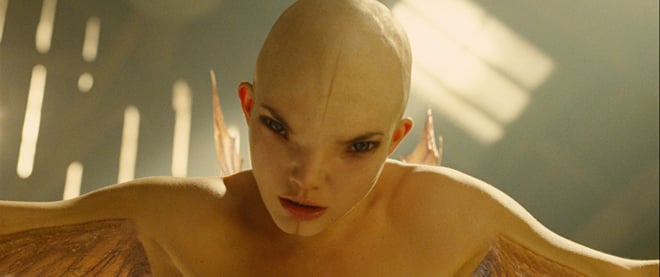Sarah Polley’s Freudian nightmare
In the psychodrama ‘Splice,’ the most awful undercurrents of parenthood come to the fore
Share
 The Avatar question always comes up. Vincenzo Natali’s Splice does, after all, feature a sexy humanoid babe with a long, restless tail. But Natali had the idea for his movie long before fellow Canadian James Cameron created his 3-D epic. It was hatched in 1997, the year Natali made his feature debut with the sci-fit hit Cube. He saw a photo of a mouse that appeared to have a human ear growing out of its back—the product of a tissue transplant experiment. “It looked like it had crawled out of a Salvador Dali painting,” he recalls. “It was a shocking image. I knew then there was a movie in that mouse.”
The Avatar question always comes up. Vincenzo Natali’s Splice does, after all, feature a sexy humanoid babe with a long, restless tail. But Natali had the idea for his movie long before fellow Canadian James Cameron created his 3-D epic. It was hatched in 1997, the year Natali made his feature debut with the sci-fit hit Cube. He saw a photo of a mouse that appeared to have a human ear growing out of its back—the product of a tissue transplant experiment. “It looked like it had crawled out of a Salvador Dali painting,” he recalls. “It was a shocking image. I knew then there was a movie in that mouse.”
Natali’s brainchild eventually grew into the most costly Canadian film on record—a $26.5-million slice of sci-fi horror starring Oscar-winning actor Adrien Brody (The Pianist) and Canadian sweetheart Sarah Polley. They play power couple Clive and Elsa, genetic engineers who combine human and animal DNA to clone Dren—a chimera with double-jointed legs, Gothic wings, and an accelerated growth rate that puts her on a fast track to becoming a freakishly hot femme fatale (Delphine Chanéac).
The making of Splice is itself a Frankenstein saga that morphed into a Cinderella story. A Canada-France co-production, this sophisticated monster movie seemed destined to go straight to video after a string of hellish negotiations with Hollywood. Interest from 20th Century Fox turned hostile when an executive deemed it too close to Avatar. And a deal with MGM collapsed when that studio hit dire financial straits. Under pressure from his French partners, who financed two-thirds of the budget, Splice’s Toronto producer, Steve Hoban, was on the verge of signing a lucrative direct-to-DVD deal before the film’s Sundance premiere last January. But then Hollywood mogul Joel Silver (The Matrix) saw a still from the film and was intrigued. A print was sent to his house. Silver loved the film and showed it to Warner Bros. This weekend Warner is releasing Splice on some 3,000 screens across North America, backed by a print and marketing campaign costing US$32 million—more than the film’s budget.
“It’s outrageous,” Natali told Maclean’s. “Never in my wildest imaginings did I think we’d get a release by a major studio.” He had assumed the movie’s subversive tone and twisted sexuality would make Hollywood uncomforable. “An American film would have the creature escape from the lab and wreak havoc in the world,” says Natali. “Instead the scientists imprison it, and the film becomes a psychodrama, a hermetic chamber piece.”
Splicing horror and dark comedy, Polley plays a scary hybrid of mad scientist and mad housewife, an insanely protective mother who raises Dren as her own bastard child. “It’s a Freudian nightmare,” said the actress, interviewed at last week’s Toronto premiere. “The most awful undercurrents of parenthood come to the fore, and we get to play them.”
Splice is deeply reminiscent of David Cronenberg’s early work, an influence that Natali, 41, readily concedes. “When you enter the world of bio-horror,” he says, “you are using DNA trademarked by Cronenberg.” As for other influences, he cites James Whale’s Frankenstein, Ridley Scott’s Alien and François Truffaut’s The Wild Child—but not Avatar. Before he began shooting in 2007, however, Fox threatened to sue unless he redesigned his creature, despite assurances from James Cameron that he was unconcerned. Natali stood his ground. No one can claim copyright on bestial characters with tails, which are older than the Devil. “When I saw Avatar,” he says. “I was immensely impressed. But the Na’vi are blue and fantastical. I hope Dren could actually exist in our world.”
In fact, since Splice was scripted, science has begun to catch up with it. In 2007, Britain legalized experiments combining human and animal DNA. And just two weeks ago, genome pioneer Craig Venter created the first synthetic bacterial cell. Natali says he himself is “a hybrid.” Born in Detroit to an Italian-American father and British-Canadian mother, he grew up in Toronto and now lives in Los Angeles. He carries two passports—and perhaps the genetic blueprint for a new breed of Canadian cinema.